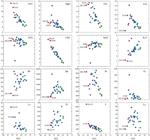Abstract
The São João do Sabugi Pluton (SJSP) (∼579 Ma) is one of the most expressive occurrences of Ediacaran, syn- to post-collisional shoshonitic rocks in the Rio Piranhas-Seridó Domain, Borborema Province, NE Brazil. The petrography, whole rock and mineral composition of this pluton were investigated to characterize its open-system magmatic differentiation processes. The pluton is composed of three rock groups: gabbro-diorite, with clinopyroxene ± orthopyroxene ± amphibole ± biotite; monzodiorite, with amphibole and biotite (± pyroxenes); and granodiorite, with biotite as the main mafic mineral. Evidences of open-system processes, including partially resorbed metasediment xenoliths, are widespread. These rocks are metaluminous, alkali-calcic and magnesian, and have shoshonitic affinity. They show relative LILE and LREE enrichment and pronounced negative Nb-Ta anomalies. Major and trace element geochemical modeling favors magma differentiation by fractional crystallization (56–62%) after crustal assimilation of ∼30% of local paragneisses and schists from the Seridó Group in a relatively stationary magma chamber at crustal depth, under pressures of 5–6 kbar, temperatures of ∼800–1,000°C and relatively oxidizing conditions. The less evolved gabbro-diorite was generated by ∼18% modal dynamic partial melting of a metasomatized mantle source.
KEYWORDS
São João do Sabugi Pluton; geochemical modeling; open-system processes; shoshonite; Borborema Province

 Thumbnail
Thumbnail
 Thumbnail
Thumbnail
 Thumbnail
Thumbnail
 Thumbnail
Thumbnail
 Thumbnail
Thumbnail
 Thumbnail
Thumbnail
 Thumbnail
Thumbnail
 Thumbnail
Thumbnail
 Thumbnail
Thumbnail
 Thumbnail
Thumbnail
 Thumbnail
Thumbnail
 Thumbnail
Thumbnail
 Thumbnail
Thumbnail
 Thumbnail
Thumbnail
 Source: modified from
Source: modified from 











